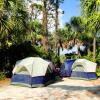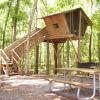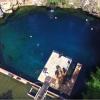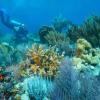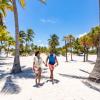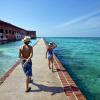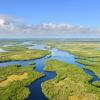By Michelle Bearden
Elly Lamme loves exploring Florida, but the Ellie Schiller Homosassa Springs Wildlife State Park was not high on her list.
What to Expect
“I thought it was a zoo, and I’m not fond of looking at caged wild animals,” says the Netherlands native, who lives part-time in nearby Inverness, Fla. “It’s just not my thing.”
But after a friend persuaded her to pay a visit to the park, Lamme came away with an entirely different viewpoint of the 210-acre facility in Citrus County that put her misconceptions to rest.

A wild wood stork joins the resident birds at Homosassa Springs Wildlife State Park during feeding time.
- Julie Branaman for VISIT FLORIDA

Wild ibis join the resident birds at Homosassa Springs Wildlife State Park during feeding time.
- Julie Branaman for VISIT FLORIDA
She learned that the park is actually home to rescued animals and rehabilitated birds and animals native to Florida, with the exception of 55-year-old Lu the hippopotamus, famously declared an honorary citizen of Florida by the late Gov. Lawton Chiles. The park residents, most unable to survive in the wild, now live safely on diets and in habitat as close to natural as possible.
Informal educational programs by park volunteers and staff, along with detailed story boards at each exhibit, gave Lamme insight into the history of the furry and feathered that make their home here. Among them: a black bear, Florida panthers, alligators, cougar, red wolves, bobcats, Key deer, gray fox, otters and a dedicated building just for reptiles. A bird lover, she was thrilled by the flock of flamingos, the roseate spoonbills, wide-eyed owls, herons, egrets and the majestic hawks and bald eagles.
And getting an up-close and personal view of the massive West Indian manatees feasting on lettuce leaves in the park’s freshwater springs meant she could cross another item off her bucket list.
Best of all, Lamme says, is the ambiance. Visitors can begin with a short pontoon boat ride down Pepper Creek guided by a captain who points out details such as sunbathing turtles, nests of blue herons and the red cedar trees along the shoreline.

Two bald eagles at Homosassa Springs Wildlife State Park
- Julie Branaman for VISIT FLORIDA

The park takes visitors through a variety of animal and bird exhibits.
- Julie Branaman for VISIT FLORIDA
Back on land, visitors follow a path on boardwalks and paved trails in a lush tropical setting under a canopy of grand oak, cypress and palm trees. Even on the hottest summer day, there’s the comfort of constant shade on the jungle-like grounds.

One of the Florida black bears at Homosassa Springs Wildlife State Park sleeps while visitors get a close look. There are two bears at the park. Both were found as cubs in Ocala National Forest abandoned by their mother.
- Julie Branaman for VISIT FLORIDA

Visitors to Ellie Schiller Homosassa Springs Wildlife State Park can hop aboard a pontoon boat for a ride along Pepper Creek or take a tram to the park entrance.
- Julie Branaman for VISIT FLORIDA
Visitor Testimonials
Now, Lamme is one of the park’s many devoted fans, calling it a “true hidden treasure” on the state’s Nature Coast.
“Anyone with an interest in what makes Florida unique needs to put this place on a must-see list,” she says. “Once isn’t enough. It’s the kind of place where you can return time and time again and see something different.”
Susan Strawbridge loves to hear testimonies like this.
Her fondness for the park is evident: She’s been a part of the operation here for 35 years. A nature lover, she used to visit on her days off, and eventually became its weekend photographer. Strawbridge was officially hired in 1978, working in advertising and marketing. Now she’s a park services specialist, acquainted with nearly every facet of the sprawling property and its inhabitants.
She’s witnessed its vast changes over the years, from a privately owned attraction with exotic animals and shows, to its evolution as a Florida state park with a new focus on the preservation of natural and cultural resources, along with interpretative programs and exhibits that rotate monthly.
“This is truly real Florida,” she says. “Even after many years of working here, I find that every day brings new experiences that continue to inspire me. I never get tired of coming to work.”

A flock of flamingos resides at Homosassa Springs Wildlife State Park.
- Julie Branaman for VISIT FLORIDA

The Fish Bowl underwater observatory at Homosassa Springs Wildlife State Park offers a unique view of a school of snook.
- Julie Branaman for VISIT FLORIDA
It became a tourist attraction back in the early 1900s, when the “Mullet Train” would stop here to let passengers off to view Homosassa Springs and its multitude of colorful fresh and saltwater fish, while the crews would load up freight of fresh crab, cedar, spring water and fish. In the 1940s, the 50-acre site and surrounding 100 acres were purchased and developed as a small tourist attraction. It got a new owner again in 1964, and given the name “Nature’s Own Attraction.” Ivan Tors Animal Actors brought the animals they trained for television and movie roles when they weren’t performing on set.
After several more ownership changes, the Citrus County Commission purchased the property in 1984 to protect it as an environmentally sensitive area until the state could take over a few years later. With partnerships with groups like the Florida Wildlife Commission, U.S. Fish and Wildlife Service, veterinarians and conservancy organizations, it has become a hospital and haven for animals in need.
“We call this an assisted living facility,” says Strawbridge, laughing.
Arguably the most popular draw is the manatee viewing pool, where visitors can attend an informative program on one of Florida’s most beloved mammals. The park also has an education center dedicated to these gentle giants, an endangered species under federal protection.
A vestige of a bygone era is the 157-ton, 55-feet deep underwater observatory in the springs of the headwaters of the Homosassa River at the park’s entrance. Its engineering feat was so innovative for its time that Popular Mechanics published a story about it in its January 1965 issue. A framed copy of that weathered article is hung in the floating structure, where the descent is a few steps down to an oversized viewing area. Here, visitors can see dozens of species of fish glide by, depending on the time of year.
More national exposure is in the works. National Geographic Wild is planning upcoming segments on two of the park’s most captivating stories. One will focus on the enduring love tale of whooping cranes Levi and Peepers, and another on Yuma, the baby Florida panther found abandoned by biologists at a week old, with his eyes still closed. Through a collective effort of wildlife groups and veterinarians from ZooTampa and the park, the panther is healthy and vibrant now, though he will never possess the skills necessary for survival in the wild.
“He belongs to us now,” Strawbridge says. “That’s what makes this place so special. We provide an environment where we can give animals like Yuma a second chance, and in turn, he can teach us so much about the importance of protecting the wildlife that shares our land.”
She says the woman whose name is now part of the park would be proud of what it has become. The late Ellie Schiller, who used her degree in biology for a career in state fisheries, was an environmentalist-philanthropist who supported many causes through her family’s charity, the Felburn Foundation. The park’s mission of education and preservation reflects the same principles that guided Schiller’s life.
For Lamme, experiencing Homosassa Springs Wildlife State Park made her realize why she fell in love with Florida in the first place and made this her second home.
“Its natural beauty can take your breath away,” she says. “This isn’t man-made. This is the real deal.”
When you go…
Ellie Schiller Homosassa Springs Wildlife State Park, 4140 S. Suncoast Blvd., Homosassa, is about 75 miles north of Tampa on U.S. 19 and 90 miles northwest of Orlando. It’s open 365 days a year, 9 a.m. to 5:30 p.m. Admission is $13 for adults (age 13 and older) and $5 for children (ages 6 through 12). Pets are not permitted, with the exception of service animals. Kennels are provided free at the Visitor Center.
For more information, call (352) 628-5343 or (352) 628-2311, or visit https://www.floridastateparks.org/parks-and-trails/ellie-schiller-homosassa-springs-wildlife-state-park.
PLACES TO REMEMBER
RELATED CONTENT
Experience Florida's Wild Side at Homosassa Springs Wildlife State Park
- 8 minute read
By Michelle Bearden Elly Lamme loves exploring Florida, but the Ellie Schiller Homosassa Springs Wildlife State Park was not high on her list. What to...
Great Hiking Trails in Florida
- 10 minute read
By Lauren Tjaden With varied terrain and tremendous ecological diversity, Florida provides hikers of every skill level a perfect backdrop for exercise...
10 Florida Trails You Need to Experience
- 5 minute read
Want to experience the splendor of greenways and trails? Florida's your place. Outdoor enthusiasts are encouraged to step off of the beaten path...


